Some of the links in this post may be affiliate links.
The ubiquitous Sansevieria! Or Snake Plant as many of us say. Snake plant care is very easy, and in fact, they tolerate a wide variety of abuse and conditions! Snake plants are among the very easiest and best plants for beginners, or anyone for that matter.
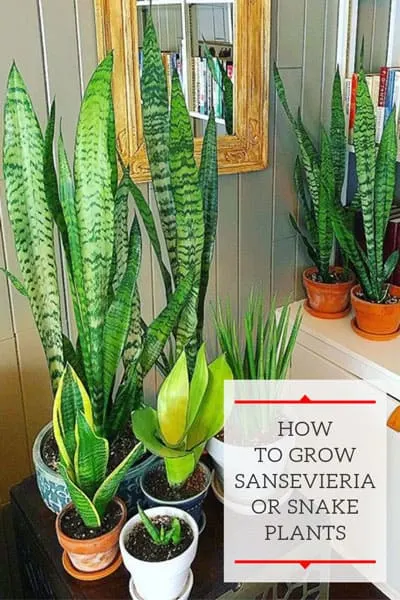
Yet another name for snake plant, although more old fashioned, is mother in law’s tongue. Whatever you call it, this plant is so much more than the pathetic specimens that you may see tucked away in a dark corner somewhere.
And there are so many more varieties than the tall, plain green variety that you see planted everywhere in shopping malls. Sansevieria should be celebrated and pampered! Not relegated to a dark corner.
So let’s get into looking at some varieties of Sansevieria, and then look at what snake plant care looks like.
Table of Contents
VARIETIES OF SANSEVIERIA
I didn’t used to be into snake plants, but once I started growing more and more varieties, they become very addictive! Take a look at all the beautiful varieties below. I selected a few from my collection to display.
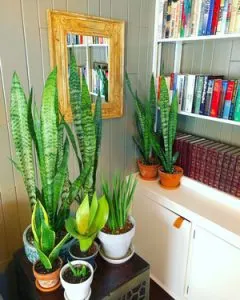
As you can see, there are many varieties of snake plants with all sorts of different shapes, heights, forms, and colors.
Here is a variety I’m growing with yellow variegated leaf edges, Sansevieria trifasciata ‘Laurentii’:
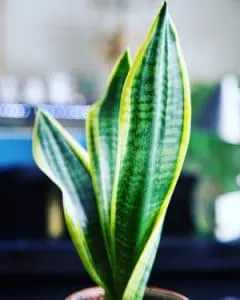
This one is called Sansevieria cylindrica, with its round leaves that I absolutely love. I’ve also written a blog post specifically on growing Sansevieria cylindrica so don’t miss it!
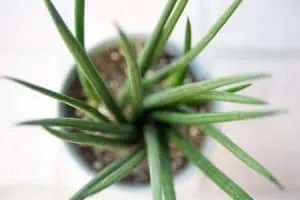
And here is one that I’ve had well over 10 years. I believe it is Sansevieria ‘Hahnii.’ I love the short clumping habit.
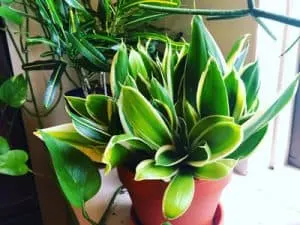
And one of my favorites, the Whale Fin Snake Plant, Sansevieria masoniana.
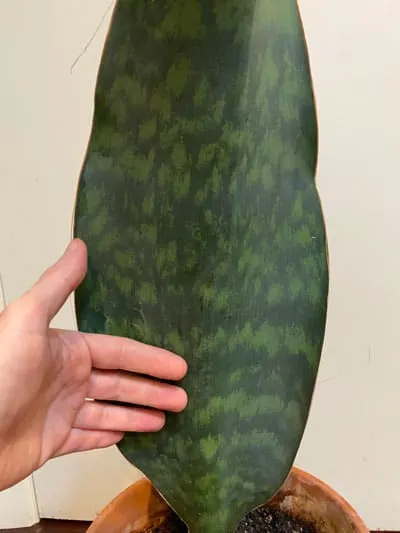
There is a Sansevieria for everyone’s taste! And there are many more varieties of snake plants than is listed here. The variety actually is quite staggering!
Now let’s get into what snake plant care looks like.
SNAKE PLANT CARE
SANSEVIERIA LIGHT
Light is a highly misunderstood topic in general when it comes to growing plants. Especially if you read what is on plant labels. What does it mean if you pick up a Sansevieria and the label says Low Light?
Some people mistakenly think that this means that the plant NEEDS low light. This couldn’t be further from the truth. What it DOES mean is that it will TOLERATE low light.
Did you know that many Sansevierias in nature grow in plenty of direct sunshine? This is a far cry from the “low light” perception that is conveyed from reading a plant label.
That being said, this plant IS in fact tolerant of low light. However, if you want a truly beautiful Sansevieria, it is best to grow them in brighter light!
As long as you place them in front of any window (whether it is North, East, West or South), it will be infinitely better than relegating a Sansevieria to a dark corner in your home.
I personally have all my Sansevieria in both East and West windows. If you do expose your plant to significant amount of direct sunshine, just watch for any signs of leaf scorch and adjust as needed.
WATERING SNAKE PLANTS
If you follow me on Instagram (@ohiotropics) you’ve seen me preach about proper watering. Regardless of the type of plant, the way I water plants is largely the same.
So the way you’d approaching watering snake plants should be the same as any other plant. The only difference is the extent to which you should let the soil dry out in between watering.
If you read on a label that Sansevieria is a “Low Moisture” plant, what exactly does that mean?
Does this mean that you should just give your plant a tiny little drink of water at every single watering? My answer to that is, absolutely not.
Many people have been shocked at how I water plants, especially succulents like Sansevieria. I will take most of my plants (assuming that they are small enough to carry), to a sink and give them a thorough soaking. Regardless what type of plant it is!
As far as fertilizing goes, I use the Schultz Cactus fertilizer religiously for all my snake plants and succulents. This fertilizer is great for all succulents and cacti because it contains a lower proportion of nitrogen which is perfect for these plants.
CORRECT MOISTURE NEEDS FOR SANSEVIERIA
What I DO vary however, is how dry I let the soil get in BETWEEN watering. For Sansevieria, since they naturally grow in dry soil in nature, I will let the soil completely dry out before watering again.
For a fern, however, I wouldn’t dare follow this same method. I absolutely still water ferns thoroughly, but I normally wait until the surface of the soil is just barely dry before watering again.
If I were to treat my ferns like Sansevieria and let their soil dry out completely, I would have some pretty ugly and crispy ferns on my hands.
To summarize, water your plants thoroughly, but you’ll need to customize your watering regime to different levels of soil dryness, depending on the plant that you have, before watering again.
KILLING SANSEVIERIA
It is my whole hearted opinion that most people kill their succulents by either overwatering, or conversely, by not watering thoroughly. Don’t make the mistake of not watering your plants thoroughly at each watering session.
Soak the soil until water drains out through the drainage hole. Don’t let your Sansevieria sit in water however for extended periods or it may rot.
If you are skimpy with watering and don’t moisten all of the soil when you water, you will be encouraging a shallow root system, and will eventually dehydrate your plant and start a slow demise.
Moral of the story: Water your sansevieria thoroughly and then let all the soil dry out completely before repeating and watering again.
One note of caution. When you water your Sansevieria, avoid getting water stuck in the rosettes of leaves. If you get water stuck between the leaves, the plant may rot (especially at cooler temperatures).
OTHER CULTURAL NOTES
Sansevieria plants need a quickly draining soil. To keep it easy, you can purchase soil blends made specifically for succulents and cacti. I really like using the following products and they are available on Amazon:
I’ve achieved great results using the Hoffman Cactus & Succulent Soil Mix.
I always add a little pumice or perlite this ANY mix I use in order to improve porosity and drainage. There are various pros and cons to using perlite vs. pumice, so choose your favorite!
Miracle Gro makes a fantastic all purpose potting mix! I use it for a variety of houseplants with great success.
I find that I am not satisfied in general with the drainage and porosity of potting mixes, so I always add some pumice or perlite to everything.
Sansevieria plants like a sharply draining soil. If your soil is not well drained, you may risk root rot if the soil stays wet for too long.
If you’re looking for an amazing potting mix that you can use straight out of the bag for your snake plant, check out the Tropical Succulent Soil Blend from Oh Happy Plants. This is an amazing mix and you will get 10% off at checkout automatically if you use my link.
Growing houseplants is a balancing act and everyone’s conditions are different. If someone asks me how often I water a plant, I tell them that it depends!
If your plant is in a cooler and dimmer location than mine, your plant will not use up as much water and in theory will take longer for your soil to dry out. So the correct question to ask is not how often to water a specific plant, but how dry should the soil get before watering again?
Some other factors that will determine how quickly your potting mix will dry out include your choice of pot. Terra cotta pots will dry out much more quickly than other types.
I wrote an extensive blog post on the pros and cons of using terra cotta pots. I grow some of my snake plants and terra cotta, and others in glazed ceramic pots.
SANSEVIERIA FLOWERS
Did you know that Sansevieria can occasionally bloom indoors?
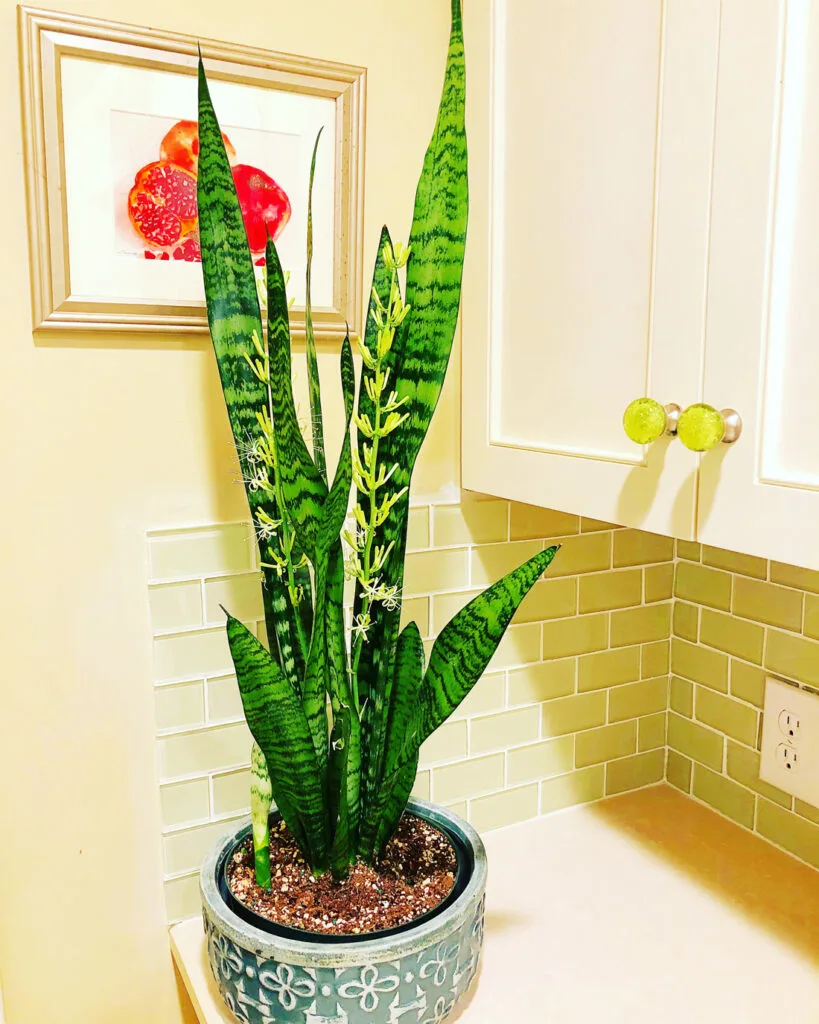
Check out my blog post on how to encourage Sansevieria to bloom for more details.
SANSEVIERIA PROPAGATION
You can easily propagate Sansevieria by simply dividing the plant when you repot. This is probably the easiest and quickest way to propagate these plants.
Another way to propagate, although MUCH slower, would be to cut up leaf segments that are a few inches long and insert them into soil.
After you cut the leaf segments up, you need to let them dry for a couple days first to allow the cuts to callous over. This prevents the leaves from rotting.
Then you can insert them partially into soil (be sure not to put them upside down though or it will never grow!) Eventually, new plants will emerge from where the leaf was cut.
For more detailed information on propagating, check out my post on the 5 ways that you can propagate snake plants.
Take care not to keep the soil too moist before the plants develop roots otherwise rotting may occur. You can read my step-by-step illustrated blog post on how I propagate Sansevieria by leaf cuttings in a dedicated blog post.
If you don’t like soil propagation, check out my step-by-step blog post on propagating snake plants in water.
Do you have any snake plants? There are so many snake plant varieties, and you’d be hard pressed to find a houseplant that is so easy to grow. Which Sansevieria varieties are your favorites?

E
Wednesday 10th of February 2021
Hi! Your blog post about snake plants has been super helpful, as well as your post about calatheas :) Thank you for them! I'm trying to figure out why my snake plant leaves are curling inward. I just got it last month. I got scared that I over watered it as I gave it a big soak and I have since waited weeks to let it really dry out, but they're still the same. I also found a worm like creature with many legs that emerged which has caused me great fright lol but yes! Is my plant dying already? Thanks so much!!
E
Monday 15th of February 2021
@Raffaele, It's winter here so we don't get a ton of sunlight right now. It's about 6 feet from the window situated with all my other plants! It's west-ish facing I guess - You can catch the sun setting from it! Thank you for your reply :)
Raffaele
Wednesday 10th of February 2021
What is the light situation for your plant? How far away from a window is it?
Kirsty
Sunday 31st of March 2019
I have a couple of variegated Sansevieria and I love them! I have had them a few years now and they seem to be doing great. However, I repotted one yesterday and I noticed the roots are very shallow. They only extend down a cm or two and about the same outwards, so the root ball is very small and doesn't seem like it would be enough to sustain this plant.
I water and care for them just as described here, and the plant does seem very healthy other than these shallow roots. I am wondering if I should be doing something else to promote some deeper root growth?
[email protected]
Sunday 31st of March 2019
Hi Kirsty. I wouldn't worry. Sansevieria are pretty shallow rooted. The proof is that you said that your plants look healthy otherwise. If the root system was not healthy, it would show in the leaves. But in general though, to promote deeper roots, you can water thoroughly and ensure that the entire potting mix is moistened. Do you fertilize? Phosphorus and Potassium both encourage better root growth. These would be the second and third numbers in a fertilizer. But again, these plants are shallow rooted. As long as the leaves look good and the growth is good, I wouldn't worry at all.
Diane
Wednesday 27th of February 2019
You’re right, we read the label at the store and it says low light low water and we think perfect and in my case you loose plant after plant of a plant that you can’t kill but I can lol. I definitely know that I was not watering mine enough at all and not giving sufficient light. When I would pick one up at the store I would think holy crap this is smoking wet that can’t be good and I would let it dry out completely and only give it a little bit of water out of fear of root rot. So I thank you for opening my eyes lol.
[email protected]
Wednesday 27th of February 2019
Glad to help, and good luck! Once you get the hang on it, they are super easy!
Ashlie T
Sunday 5th of August 2018
I’ve had my Sansiveria Black Gold for 4 years now and it’s grown quite a bit since then. When I went to repot it I found that it’s roots are very short, maybe 1-2” at best. I used a mix of 1/3 potting soul & 2/3 cactus soil mix, and it’s new pot is 2” wider than its previous one. I use your watering method but can you offer any advice to enourage more root growth?
Thank you!
[email protected]
Sunday 5th of August 2018
The end result is that you want a plant that is healthy and growing well, and it sounds like your plant is fine! Sansevieria actually have shallow root systems. As long as your plant is healthy and growing, your plant is just fine!
Marissa
Saturday 28th of April 2018
Thank you for another great post and this excellent blog! I've been perusing your posts as I start to plan and get ready for outdoor planting- your gardens are such an inspiration! I know you have a post about moving houseplants outside in warmer months, and I was wondering if you thought Sansevieria would be okay outdoors in NE Ohio, or if it is too wet? I would have it on an uncovered patio, so it would be exposed to all the elements. Although I suppose it would be easy enough to bring in during extended or frequent rain storms.
[email protected]
Tuesday 1st of May 2018
Yes you absolutely can! The first thing to do though is to harden it off properly so it doesn't burn when you put it outside...just follow my suggestions in the post. I would just keep an eye on the weather and if you are having unusually wet weather, just move the plant. Keep in mind that plants will dry out more quickly outside since it will be warmer and there is good air circulation!